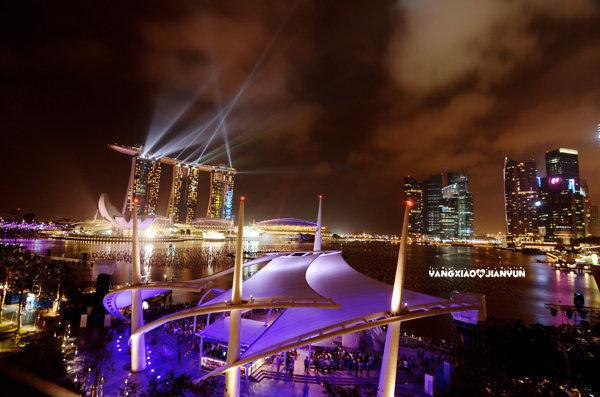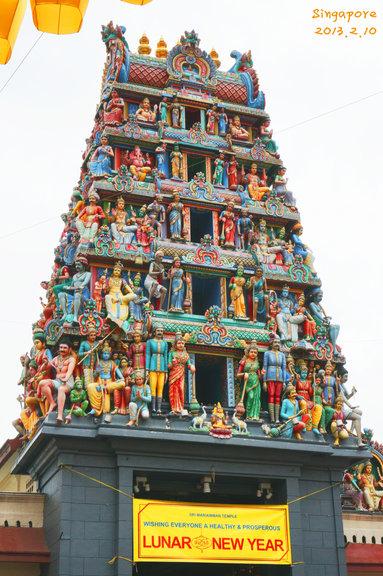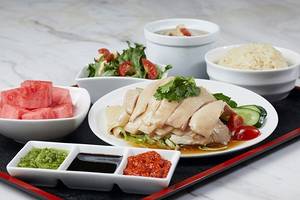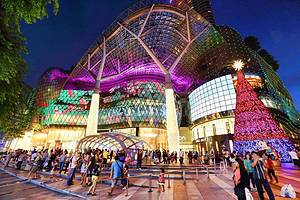6-day leisure trip in Singapore
1 cities |
25 attraction(s) |
total distance 97
km
 TIPS
TIPS
Day1
Day2
Day3
Day4
Day5
Day6
Day1: Singapore
5 attraction(s) ·
14 km
1
The Merlion is a symbol of Singapore that has developed from a small fishing village. It is also a iconic tourist attraction in Singapore. The design inspiration of the Merlion comes from a legend in the Malay Annals: In the 11th century, Prince Sang Nila Utama visited Singapura and saw a lion. The lion head of the Merlion represents that lion, while the fish tail symbolizes the ancient city of Temasek (which means "sea" in Javanese). Today, the area around Merlion Park is filled with skyscrapers and is known as Singapore's financial and business district.
2
km
2
The diameter of the Singapore Ferris wheel, which is 42 floors high, is 150 meters. It is located on top of a 3-story leisure shopping center, with a total height of 165 meters. This height exceeds that of the 160-meter-tall Nanchang Star and the 130-meter-tall London Eye. There are 28 air-conditioned cabins that can accommodate 28 passengers each. The Ferris wheel takes approximately 30 minutes to complete one rotation.
Located by the Singapore River, it offers views of the Esplanade – Theatres on the Bay, Marina Bay Sands Hotel, F1 Singapore Grand Prix circuit, ArtScience Museum, and more. In addition, it provides views of sights up to 45 kilometers away, including Indonesia's Batam and Bintan islands, as well as the state of Johor in Malaysia. The ascent of the Ferris wheel is very smooth and there is no sense of fear. It takes about thirty minutes to complete one rotation. Below the Ferris wheel, there is a "Singapore Street Food" with over 800 seats, designed and decorated in the theme of the 1960s, creating a nostalgic atmosphere.
1
km
3
The Helix Bridge, connecting Marina Bay and Marina Centre, is hailed as another landmark in Singapore. It officially opened on April 24, 2010, and is the world's first curved bridge with a length of 280 meters (Singapore's longest pedestrian walkway). Inspired by DNA structure and Asian cultural concepts, it is said to bring wealth, happiness, and prosperity to Marina Bay, symbolizing Singapore's "never-ending" spirit. Visually, the Helix Bridge, along with the Marina Bay Sands hotel on the right and the Singapore Flyer on the left, forms a group of modern and artistic architecture. During the day, visitors can enjoy views of the Singapore River, the Civic District, and the Marina Bay area while crossing the bridge and encountering locals jogging. At night, the bridge is adorned with various lights, creating a charming and dreamlike atmosphere, even on the ground. The Helix Bridge not only serves as a viewing platform but also connects the Merlion, the Esplanade - Theatres on the Bay, and the Marina Bay Sands hotel.
4
km
4
Singapore's new landmark, winner of the World Building of the Year 2012 award, consists of a greenhouse (Flower Dome and Cloud Forest), 18 Supertrees, a Cultural Heritage Garden, a Plant World, Dragonfly Lake, and Kingfisher Lake. At the beginning of 2014, a new children's park suitable for kids to play in was also opened.
Covering an area of 101 hectares, the garden is home to over 250,000 rare plants. It is composed of three gardens: Bay South, Bay East, and Bay Central. Walking along the waterfront promenade, you can enjoy the enchanting skyline of the Marina Bay Financial District. It is a great place for night strolls and picnics with family and friends.
7
km
5
The Esplanade - Theatres on the Bay is Singapore's leading performing arts venue. Its unique dome architecture has earned it the nickname "durian". Located by Marina Bay, the Esplanade houses a concert hall, theaters, recital studios, and rehearsal rooms, as well as outdoor performance spaces. In addition, there are shopping centers, international restaurants, and Singapore's first arts library - the Esplanade Library, which contains a large collection of books and multimedia resources on music, dance, film, and theater.
The local and international performances staged at the Esplanade range from musicals, concerts, dance, theater, to outdoor performances and lunchtime concerts, offering a diverse range of formats, sometimes even free. The night view is beautiful, so remember to bring a tripod for photography.
Day2: Singapore
5 attraction(s) ·
10 km
1
St. Andrew's Cathedral is the largest Anglican church in Singapore and one of the most precious architectural works in Singapore. The current St. Andrew's Cathedral, designed by Colonel Ronald McPherson, was built in 1857 after the original building was struck by lightning twice, giving it a strong Neo-Gothic architectural style. In 1973, it was officially designated as a national monument due to its towering spires and gleaming white appearance, making it stand out in the area.
3
km
3
ArtScience Museum is one of the attractions in Marina Bay Sands. The museum deeply explores the driving forces behind creative thinkers, how to obtain and utilize them, and how our world is transformed by them. It hosts various exhibitions and programs, combining beautiful design, engaging content, and knowledge discussions to tell creative stories and inspire creativity in all of us. With its iconic design, the ArtScience Museum covers a total area of 4,645 square meters and has 21 exhibition spaces, making it an ideal venue for hosting large-scale international exhibitions of the world's most famous collections.
3
km
4
The Singapore Art Museum, also known as the Singapore Museum of Art, was formerly a century-old school building, the Old Saint Joseph's Institution. Opened in 1996, it houses over 400 artworks and has the largest collection of local and contemporary Southeast Asian art in the world. It is a leading art museum in Southeast Asia in terms of exhibition scale and state-of-the-art facilities in all-weather and video galleries. The Singapore Biennale, a global art event, is held biennially and organized by the Singapore Art Museum.
2
km
5
Clarke Quay is a tourist attraction located at the corner of Singapore River and River Valley Road. It is named after Sir Andrew Clarke, the second governor of Singapore. It is known for its various bars and the famous Jumbo Seafood restaurant. It is also the best place to experience Singapore's nightlife. If you have a strong heart, you can also try the G-MAX Reverse Bungee at the entrance.
Day3: Singapore
3 attraction(s) ·
4 km
1
Sentosa is a comprehensive leisure resort island, offering pure beaches, world-class tourist attractions, watersports facilities, golf courses and holiday resorts. It is a popular destination in Singapore, attracting 2 million visitors annually. The southern coast of the island features over 2 kilometers of beaches, Fort Siloso from World War II, two golf courses, and 7 hotels. Notable attractions include Sentosa Nature Discovery and Universal Studios Singapore.
Useful tip: UnionPay cards are accepted for ticket purchases and at merchants within the resort.
2
km
2
Universal Studios Singapore is an amusement park under Universal Studios, located in Asia. It is divided into different areas such as Hollywood, New York, Ancient Egypt, Sci-Fi City, and Far Far Away. The must-try experience here is the world's tallest dueling roller coaster, with zero gravity spins, corkscrew twists, spiral twists, and vertical loops that will surely leave you thrilled. You can also enjoy the exhilarating Transformers 3D Battle. Inside the park, there are various restaurants and souvenir shops for you to enjoy delicious food and shopping. Tip: UnionPay cards can be used to purchase tickets and make purchases at the park's merchants.
3
km
3
Merlion in Sentosa Park
As a symbol of Singapore, the Merlion is the most famous attraction in Sentosa. In fact, there are two famous Merlion statues in Singapore, one is located in Merlion Park in front of the Fullerton Hotel, and the other is this one in Sentosa Park, standing at 37 meters high. Climbing to the top of the tower allows for a 360-degree view of Singapore's beautiful scenery, and even distant islands can be seen.
Day4: Singapore
3 attraction(s) ·
28 km
1
The world's largest oceanarium. The marine creatures in the aquarium are distributed based on geographical locations, ranging from the Strait of Karimata and Javan Sea, the Malacca Straits and Andaman Sea, the Bay of Bengal and Laccadive Sea, the Persian Gulf and Arabian Sea, the Red Sea, East Africa, to the South China Sea, completing a global journey across the oceans. The main feature of the oceanarium is the world's largest ocean window. Sitting in front of the huge glass window, watching various fish swimming, you will be amazed by the fascinating wonders of the sea.
7
km
2
Before the British landed in Singapore in 1819, Chinese laborers from the south were already engaged in the cultivation of betel nut and pepper here. Over time, more and more Chinese immigrants from the south of China came to Singapore, and specifically settled in the area along the boat quays in the southwest of the Singapore River. At that time, Singapore did not have its own water supply system, so water had to be transported by ox carts from wells in Telok Ayer and Serangoon Road. As a result, this area, where water was supplied by ox carts, became known as Chinatown.
The original Chinatown Heritage Centre is located in an ordinary house on Pagoda Street and can easily be overlooked. As many Chinese people in Singapore come from the provinces of Fujian, Guangdong, and Hainan, there is a strong Southern Chinese atmosphere here. The museum showcases the early life of Chinese immigrants, allowing visitors to experience life in the 19th century and gain an understanding of the hardships faced by Chinese immigrants in their daily struggles.
22
km
3
Night Safari in Singapore is the world's first wildlife park for visitors to explore at night. It is different from other illuminated zoos at night and not a modern nocturnal bio-dome found in other zoos around the world. Visitors can enjoy watching wildlife in the tropical jungle at night, providing a unique experience. You can take a tram ride that lasts about 45 minutes with English commentary, or explore on foot. There are exciting animal shows at 19:30, 20:30, 21:30 every night, and at 22:30 on Fridays, Saturdays, and eve of public holidays.
Day5: Singapore
6 attraction(s) ·
8 km
1
Little India is a gathering place for the Indian community in Singapore, resembling a microcosm of India. During Deepavali, the Hindu Festival of Lights, Little India is decorated like a magnificent mythical world.
In 1819, when Sir Stamford Raffles sailed to Singapore, he was accompanied by several Indian assistants and soldiers, making them the earliest Indian immigrants. More Indian immigrants came to Singapore afterwards, and the Indian community's settlement area continued to expand, leading to its current size.
One of the main roads here, Serangoon Road, is one of the oldest roads in Singapore. At that time, this area was still a large forest, often inhabited by wild animals and poisonous snakes, so the people living here would strike copper gongs to drive them away. In Malay, this is called "di-serang dengan gong," which eventually evolved into "Serangoon" today.
In Little India, you can see many old shops and stalls scattered along the roadside, alleyways, and back streets. Fortune tellers and parrots are waiting for interested visitors, while flower sellers weave beautiful jasmine garlands. Hawkers selling kachang puteh (roasted nuts) push their carts, and newspaper stands on the street display various newspapers of all kinds. The Sri Veeramakaliamman Temple is also one of the must-see attractions in Little India, dedicated to the goddess Kali.
Little India is particularly lively on Saturday and Sunday evenings because Indian workers in Singapore like to come here for meals, shopping, or gatherings with friends. It is quieter during weekdays from Monday to Friday.
Here, you will find Mustafa Centre, Singapore's most affordable shopping center, selling home furnishings, decorations, food ingredients, Indian spices, clothing fabrics, electronic products, and more. They also have Indian ethnic silverware, copperware, jewelry, jasmine garlands, Indian curry powder, and silk sarees. The Banana Leaf Apolo and Muthu's Curry Restaurant are highly recommended for their hand-pressed rice dishes, and Komalas is well-known for its vegetarian snacks.
When visiting Little India, be sure to experience Henna tattooing. You can find a small shop and have an artist use Henna paste, made from the Henna tree, to create beautiful Indian designs on your skin, which can last for a week.
The main streets of Little India are Serangoon Road and its alleys such as Campbell Lane, Dunlop Street, and Hindoo Road. There have been riots in the past, but the unrest in India is a long-standing social issue. Currently, it is safe. It is recommended to visit Little India as it is a place with unique ethnic characteristics, with exotic architecture, food, and shops.
2
km
2
Sultan Mosque was built in the early 18th century and is one of the most important mosques in Singapore. It was designated as a national monument on March 14, 1975. Located at the end of Bussorah Street, it offers the best view of the mosque, which has become a gathering place for many cafes, antique shops, and traditional clothing stores.
1
km
3
Haji Lane is a quiet alley in Kampong Glam, Singapore, with many unique shops worth exploring. It used to be an empty street lined with pre-war houses, but now it has been revitalized by the influx of local designers and young entrepreneurs. Many designers and entrepreneurs have opened boutique fashion stores here, specializing in selling various fashionable accessories and items with a local Singaporean flair.
1
km
5
Sri Mariamman Temple, Singapore's oldest Hindu temple, can be traced back to 1827. It is dedicated to the goddess Mariamman, known for her healing abilities. This Dravidian-style temple has a tower with sculptures of gods and mythological creatures, reflecting the influence of South Indian architecture. Visitors come here to seek the healing power of the deity. The temple is also a popular venue for celebrating Deepavali (Thimithi) and Hindu weddings.
3
km
6
Built in 1826, it is one of the earliest mosques in Chinatown and one of three mosques built by South Indian Tamil Muslims in Chinatown. It is famous for its unique architectural style, with a front façade resembling an intricately complex palace, with small doors and cross-shaped windows. The entrance is in typical South Indian style, while the two prayer halls and shrine are in neoclassical style. Therefore, although it is a mosque with a crescent symbol, it is very different from the architectural style of mosques in China.
Day6: Singapore
3 attraction(s) ·
34 km
1
Established in 1822, the Singapore Botanic Gardens is located near the city center and covers an area of 64 hectares. It is home to many rare species and reflects the professionalism and diversity of the Singapore Botanic Gardens. Local residents enjoy walking, picnicking, jogging, and even taking wedding photos here.
Another highlight of the gardens is the National Orchid Garden, which features over 1,000 orchid species and over 2,000 hybrids, including Singapore's national flower, the Vanda 'Miss Joaquim'. Nature lovers and plant enthusiasts should definitely pay a visit.
The Singapore Botanic Gardens also houses the first children's garden in Asia, the Jacob Ballas Children's Garden, which offers a unique learning experience in horticulture. Visitors also have the opportunity to enjoy free symphony concerts or simply go for a jog in their running attire.
16
km
2
The Wanli Huji Flower Park is mainly composed of the Vintage Garden, Water Garden, and Tropical Fruit Orchard. It showcases a variety of Huji flowers, including Singapore's national flower, the Vanda Miss Joaquim, as well as various rare potted plants from around the world. It is one of Singapore's most famous horticultural tourist destinations.
19
km
3
Orchard Road is a famous shopping street in Singapore. It is lined with more than thirteen large shopping centers, offering a wide range of products, from luxury goods to antiques, electronics to fashion brands. Whether you are a shopaholic or not, you can enjoy the unique architecture, taste local cuisine, and have a great shopping experience on Orchard Road. During the Formula One Grand Prix in September, there are many activities and exhibitions related to F1 on both sides of the road, providing special discounts and limited edition products for ticket holders. It is an exciting addition to the shopping experience in Singapore. If you exit from Orchard MRT Station, you can reach all the places in this commercial district along Orchard Road, with the furthest being Dhoby Ghaut in just 20 minutes.











































